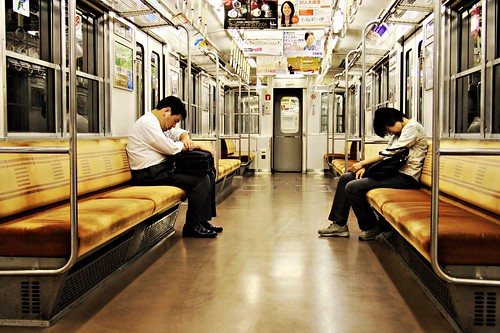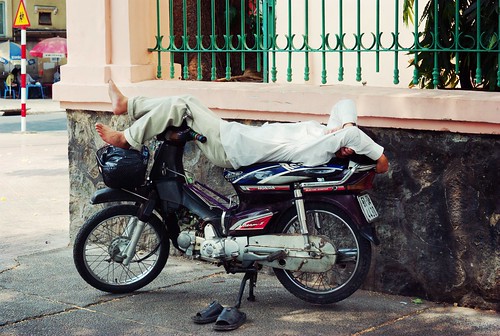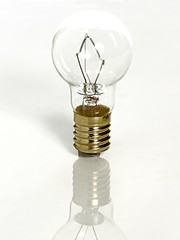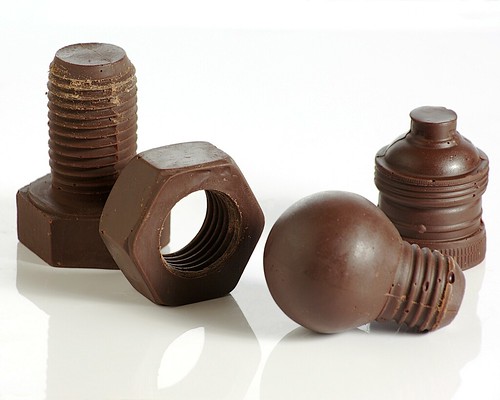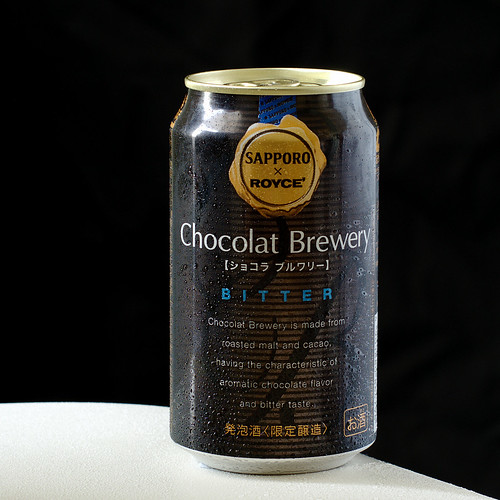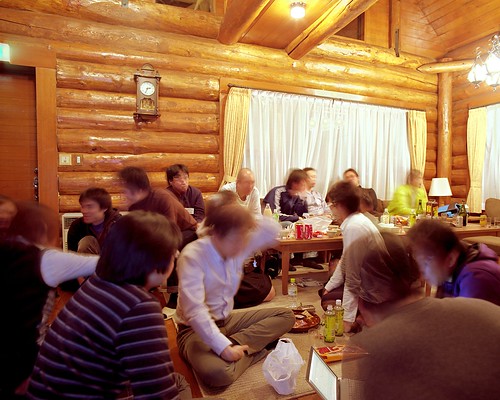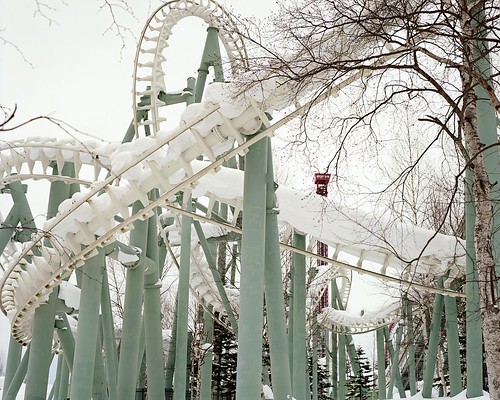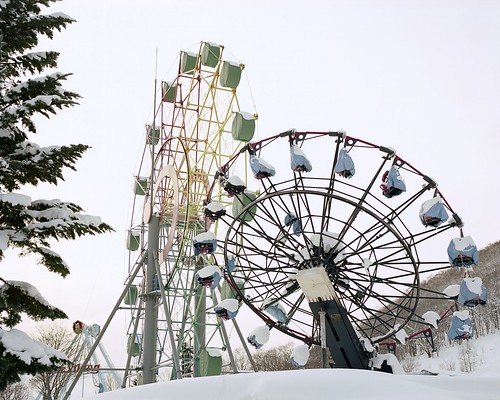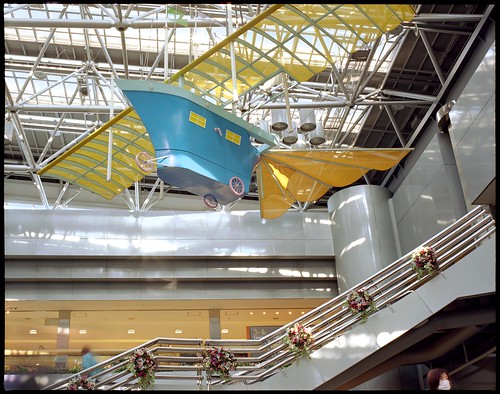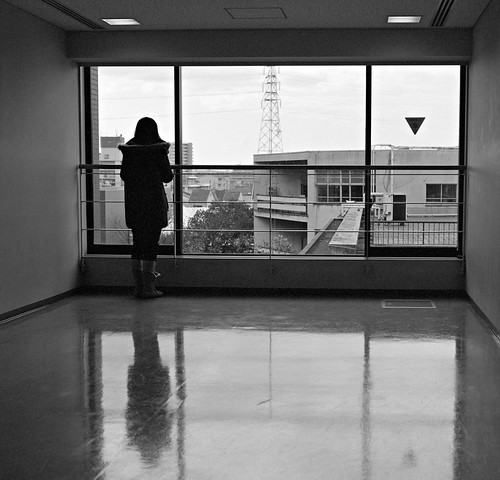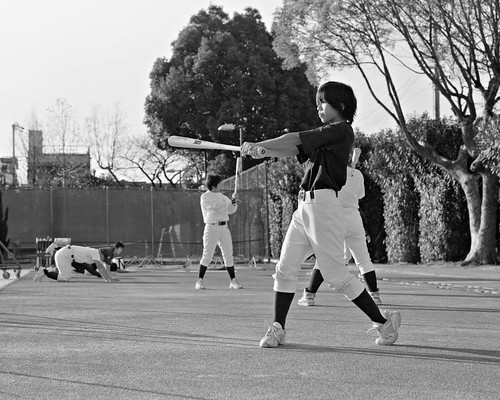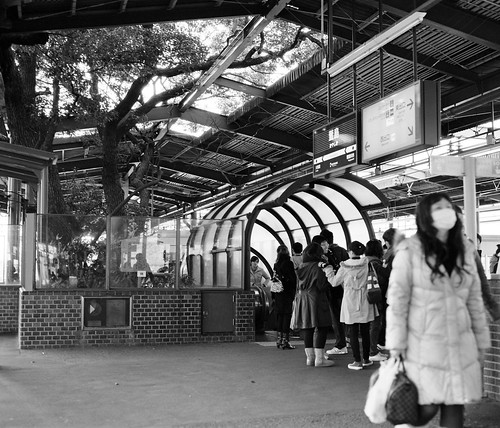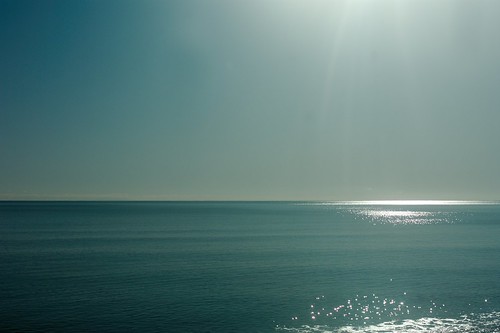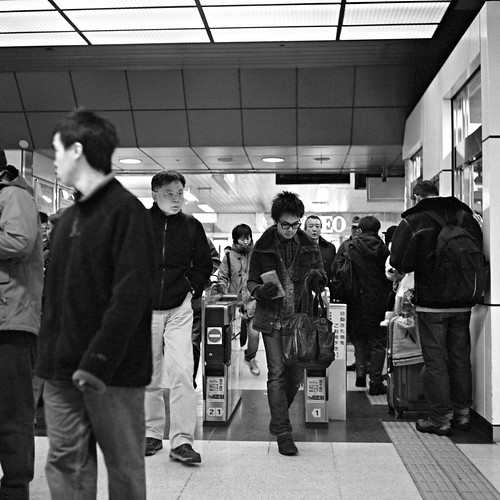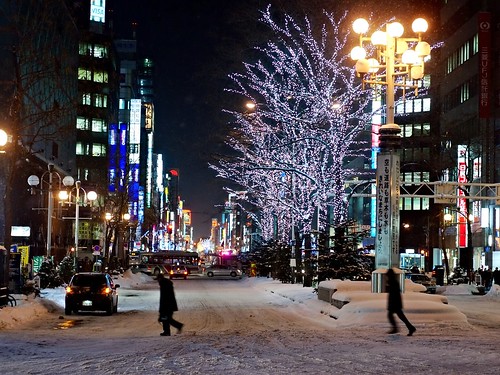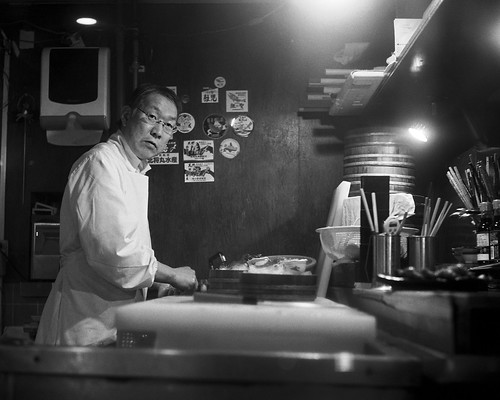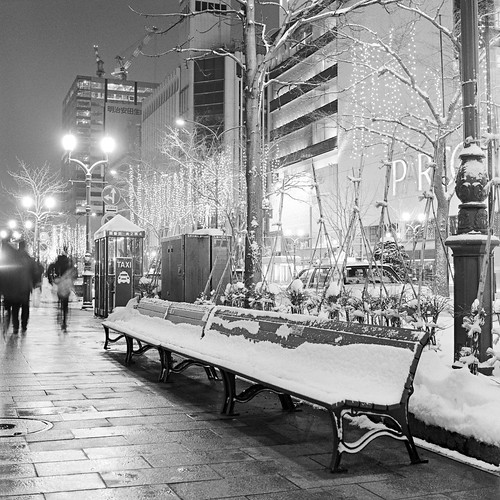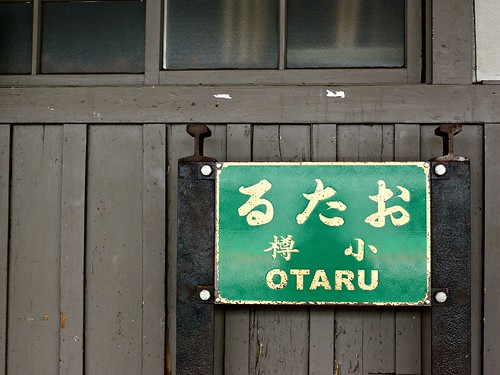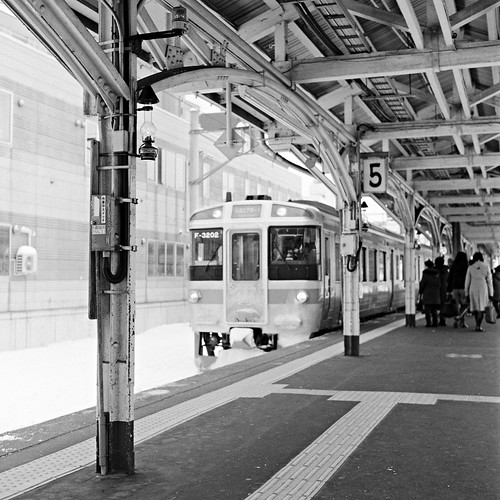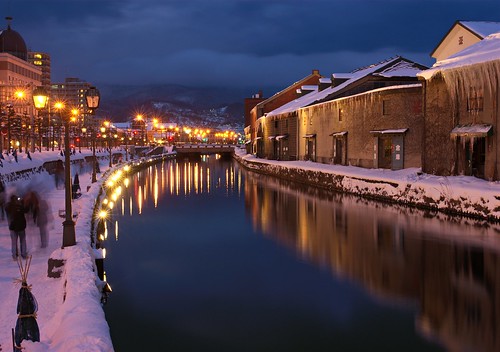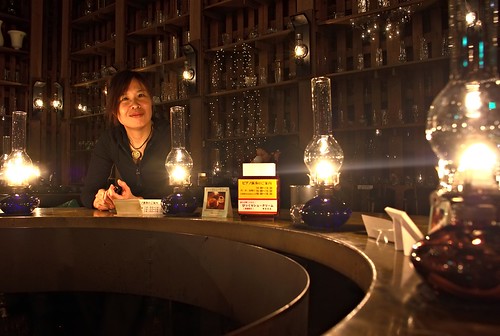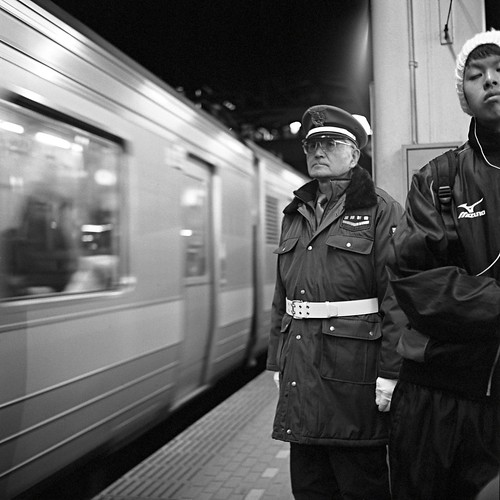The paper I'm doing starts to look decent by now (not that it's any guarantee for it being accepted of course), but I'm not going to have much time for blogging or anything until it's submitted. However, I saw an interesting, short article on midday naps in the Economist, and thought I'd point it out.
The article reports on some resent experimental research that shows that napping improves memory performance; about 1-1.5 hours is optimal. I really don't have too much time to comment on it, to say nothing of going through the original paper, but I didn't want to ignore it altogether. After all, sleep is something dear to all of us, and something that's been on my mind quite a bit lately (in the "Oh, for a few more hours of sleep" sense).
When you think about it, not having a siesta is pretty weird. Most cultures have condoned, or even encouraged, a longish break around midday. Our own bodies seem to have a pretty strong opinion on the matter too; I know I can't get a single thing done during the hour right after lunch. I usually sit half-asleep staring blankly at my work, or I spend the time with something that doesn't require much actual thinking - browsing the web, writing the blog, that sort of thing. But as this research points out, it's probably better to stop fighting it, lean back and take a real, refreshing nap instead.
Friday, February 26, 2010
Tuesday, February 23, 2010
Fifteen
..degrees, that is, with a hazy midday sun making it feel even warmer. After lunch I bought the first ice cream of the year and ate it while enjoying a short walk around the campus area.
Then, spring weather or not, back to my desk and to the paper I'm trying to beat into shape in time for a submission deadline.
Then, spring weather or not, back to my desk and to the paper I'm trying to beat into shape in time for a submission deadline.
Sunday, February 21, 2010
Library Without Librarians (sometimes)
Still fighting the conference paper. We got ourselves a deadline extension. That's another week to make the paper presentable (Yay!) - and another week of harried writing, with little time for modelling, Japanese lessons or anything else (Booo!).
Anyway, here's a bright idea (I needed an excuse to use the image on left): A library in Veberöd outside Lund, Sweden, is open on evenings without librarians or anybody else. The light is left on and the door unlocked when the staff leaves in the evening and people can come in to read, borrow and return books by themselves. It closes at ten when a caretaker presumably shoos out the visitors and locks the doors. It's such a success that they now consider extending the opening hours of most libraries in Lund in the same way.
A few reactions of mine:
First, this would probably not be possible without automation. All books are tagged so borrowing and returning can be done automatically - put the books on the borrowing counter, swipe your library card and they're all registered. Also, unchecked books will set off an alarm at the door if someone tries to bring them out; plenty enough to deter dishonest or forgetful patrons. It's not stated outright but I guess you need to use your library card to get inside too.
Also, this says more about the local culture in and around Lund than about anything else. A place like Veberöd is small, and library patrons at least recognize each other by sight. Lund itself is larger of course, but also very dominated by the university (more than a third of the city works or studies there) and libraries tend to have a fairly enthusiastic following. It would be difficult to cause trouble without strong reactions from other people. I'm not sure this would work as well in a large, anonymous city.
This is not about removing librarians; the article is very clear about that. It's about extending opening hours on a low budget. A good thing, as long as no local politician starts fantasizing about truly librarian-less libraries. Once upon a time the Swedish school system (it never saw a crackpot pedagogical theory it didn't like) experimented with "teacher-less lessons" in 7- to 9th grade in order to save money. Students were not impressed, nor were they stupid, and they soon became "teacher and student-less lessons" - an impressive monetary savings, if perhaps not conductive to any academic progress.
As a child I spent an inordinate amount of time in the local library (when I visited for the first time in fifteen years, the first thing the librarian said was "Oh, hi Janne, it's been a while"), and this news inspired me to take a look online for Osaka libraries. The Osaka central library is great with a huge amount of material and open every day, and I occasionally visit. But it takes twenty minutes by bicycle from home, so it's a bit too far to just casually drop in for a book or two. As it turns out, there's a branch library at the Senior Center just a couple hundred meters south of here, with opening hours almost as generous. I must check it out as soon as my workload lets up just a bit. Hey, maybe there's a book on setting up your own darkroom...
Anyway, here's a bright idea (I needed an excuse to use the image on left): A library in Veberöd outside Lund, Sweden, is open on evenings without librarians or anybody else. The light is left on and the door unlocked when the staff leaves in the evening and people can come in to read, borrow and return books by themselves. It closes at ten when a caretaker presumably shoos out the visitors and locks the doors. It's such a success that they now consider extending the opening hours of most libraries in Lund in the same way.
A few reactions of mine:
First, this would probably not be possible without automation. All books are tagged so borrowing and returning can be done automatically - put the books on the borrowing counter, swipe your library card and they're all registered. Also, unchecked books will set off an alarm at the door if someone tries to bring them out; plenty enough to deter dishonest or forgetful patrons. It's not stated outright but I guess you need to use your library card to get inside too.
Also, this says more about the local culture in and around Lund than about anything else. A place like Veberöd is small, and library patrons at least recognize each other by sight. Lund itself is larger of course, but also very dominated by the university (more than a third of the city works or studies there) and libraries tend to have a fairly enthusiastic following. It would be difficult to cause trouble without strong reactions from other people. I'm not sure this would work as well in a large, anonymous city.
This is not about removing librarians; the article is very clear about that. It's about extending opening hours on a low budget. A good thing, as long as no local politician starts fantasizing about truly librarian-less libraries. Once upon a time the Swedish school system (it never saw a crackpot pedagogical theory it didn't like) experimented with "teacher-less lessons" in 7- to 9th grade in order to save money. Students were not impressed, nor were they stupid, and they soon became "teacher and student-less lessons" - an impressive monetary savings, if perhaps not conductive to any academic progress.
As a child I spent an inordinate amount of time in the local library (when I visited for the first time in fifteen years, the first thing the librarian said was "Oh, hi Janne, it's been a while"), and this news inspired me to take a look online for Osaka libraries. The Osaka central library is great with a huge amount of material and open every day, and I occasionally visit. But it takes twenty minutes by bicycle from home, so it's a bit too far to just casually drop in for a book or two. As it turns out, there's a branch library at the Senior Center just a couple hundred meters south of here, with opening hours almost as generous. I must check it out as soon as my workload lets up just a bit. Hey, maybe there's a book on setting up your own darkroom...
Wednesday, February 17, 2010
Journal of Unpublishable Mathematics
I have a deadline coming up very soon, so little time to write here1. But while you're waiting with bated breath (yeah, right) for for some new material here, why not take some time to peruse the excellent new Journal of Unpublishable Mathematics? The first issue is already freely available online. Bertrand Russell would have approved.
--
--
#1 How is it possible to know about a deadline four months ahead of time, and still have to finish the work in a state of bewildered panic the very last week? The really sad part is of course that I do this every single time. You'd think I'd learn, right?
Monday, February 15, 2010
Valentine's Day (With Pictures!)
Valentine's day, again, and in the Japanese tradition women give chocolates to men (we reciprocate on "White Day" next month). It fell on a Sunday this year, which meant a lot less "giri-choco" - chocolates you're obliged to give to coworkers and classmates rather than lovers. So shops were pushing chocolates to buy for yourself, rather than as gifts. This is another aspect of the holiday: Lots of high-quality chocolate is sold only in the weeks before valentine, so chocolate lovers stock up on the good stuff to keep them over the year. Shops explicitly marketing to that groups is new, I believe.
Anyway, last year Ritsuko gave me some absolutely wonderful Chocolate Tools from Frantz in Kobe. Really fun idea, and excellent chocolate. So this year she got me their other speciality set:
Nut and bolt, lamp and lamp socket. In solid chocolate. The threads are real - the nut and the the bolt fit together, and the lamp screws nicely into the socket.
Here's the chocolate lightbulb and a medium size real one for comparison. It's a pretty serious chunk of chocolate.
The nut and bolt unscrewed. The only problem with them really is that the chocolate starts melting when you handle it. Should really wear gloves I guess.
Not directly related to valentine, but Ritsuko recently found this "chocolate beer" drink in a shop and brought back a can. Sapporo Beer is a large brewery of course, and Royce is a major confectionery maker from Hokkaido. It's beer brewed with chocolate beans. I expected a normal beer with perhaps a bitter hint, but to my surprise the chocolate dominates, and the beer looks like guinness - black, heavy and foamy. There's no sweetness; a clear, bitter chocolate flavour overlaying a dark beer. It was really good.
But good or not, I don't think it has much of a chance over the long run, unfortunately. It's too different be a stand-in for normal beer, and selling it as a beer will put off a lot of people that might otherwise enjoy it. It's a tough marketplace out there.
By the way, I probably had even more fun taking pictures of these chocolate parts than I will actually eating them. It's a simple setup: a white sheet in the background lit up by a strobe about 1.5-2 f-stops "too bright" so it washes out and becomes completely white. The items are on a sheet of white, shiny plastic I got at the hardware store. The plastic reflects the white sheet except in the shadow of the items, giving them a faint reflection. A second strobe from up right and a reflector (a white cloth) on the left brightens the parts so they don't just become silhouettes. It's a bit tricky; you need enough light that the fairly dark items become clearly visible, but too much light removes the reflections.
The can is even easier, with no strobe at all. There's daylight coming in from the left, and a reflector (a white shirt on a hangar) on the right reflects it back on to the can. I hung a black cloth in the shadows to give the picture a near-black background. Since it's available light you need a fairly long shutter speed and a tripod to make it work. A second reflector in the front might had been a good idea.
I spent a great afternoon shooting this while Ritsuko watched the Olympics. She knows how to make me happy.
Anyway, last year Ritsuko gave me some absolutely wonderful Chocolate Tools from Frantz in Kobe. Really fun idea, and excellent chocolate. So this year she got me their other speciality set:
Nut and bolt, lamp and lamp socket. In solid chocolate. The threads are real - the nut and the the bolt fit together, and the lamp screws nicely into the socket.
Here's the chocolate lightbulb and a medium size real one for comparison. It's a pretty serious chunk of chocolate.
The nut and bolt unscrewed. The only problem with them really is that the chocolate starts melting when you handle it. Should really wear gloves I guess.
Not directly related to valentine, but Ritsuko recently found this "chocolate beer" drink in a shop and brought back a can. Sapporo Beer is a large brewery of course, and Royce is a major confectionery maker from Hokkaido. It's beer brewed with chocolate beans. I expected a normal beer with perhaps a bitter hint, but to my surprise the chocolate dominates, and the beer looks like guinness - black, heavy and foamy. There's no sweetness; a clear, bitter chocolate flavour overlaying a dark beer. It was really good.
But good or not, I don't think it has much of a chance over the long run, unfortunately. It's too different be a stand-in for normal beer, and selling it as a beer will put off a lot of people that might otherwise enjoy it. It's a tough marketplace out there.
By the way, I probably had even more fun taking pictures of these chocolate parts than I will actually eating them. It's a simple setup: a white sheet in the background lit up by a strobe about 1.5-2 f-stops "too bright" so it washes out and becomes completely white. The items are on a sheet of white, shiny plastic I got at the hardware store. The plastic reflects the white sheet except in the shadow of the items, giving them a faint reflection. A second strobe from up right and a reflector (a white cloth) on the left brightens the parts so they don't just become silhouettes. It's a bit tricky; you need enough light that the fairly dark items become clearly visible, but too much light removes the reflections.
The can is even easier, with no strobe at all. There's daylight coming in from the left, and a reflector (a white shirt on a hangar) on the right reflects it back on to the can. I hung a black cloth in the shadows to give the picture a near-black background. Since it's available light you need a fairly long shutter speed and a tripod to make it work. A second reflector in the front might had been a good idea.
I spent a great afternoon shooting this while Ritsuko watched the Olympics. She knows how to make me happy.
Thursday, February 11, 2010
Release, or Not Release (the code)
It's Constitution Day, and everybody has the day off. Which in practical terms of course just means I've spent the day working from home; tide and deadlines wait for no man. while sitting in my study/storage room/garbage dump, I found a good blog post about a problem with software in science. Science geekery ahead; feel free to skip it.
Science basically depends on being open about what you do. You don't just publish your final results, but you also describe your methods and the reasoning that brought you there. That way other researchers can evaluate your claims and determine if your methods and analysis is sound; they can redo the same experiment or analyze the same model you did, or do a similar one and see how the result differs; they can analyze your data with different methods to see if there's more to learn from it and so on.
Science basically depends on being open about what you do. You don't just publish your final results, but you also describe your methods and the reasoning that brought you there. That way other researchers can evaluate your claims and determine if your methods and analysis is sound; they can redo the same experiment or analyze the same model you did, or do a similar one and see how the result differs; they can analyze your data with different methods to see if there's more to learn from it and so on.
However, the last couple of decades has seen two big changes. First, we use computers for everything nowadays. "Analyzing data" is practically always done using tools like R or Matlab, or using code you or people in your lab have written by yourselves. Experiments - all kinds, not just robotics or the like - are usually at least partially automated, with data collection and protocols controlled by some combination of off-the-shelf and local code. Computational models used to be rather simple, if only because deriving results wasn't possible with a complex model, but today models can be very large, very complex, and implemented by an equally large, complex stack of code.
The second big change is that the amount of data has exploded. We can grab huge amounts of data today, things that simply weren't possible a generation ago. Think of the possibilities of DNA analysis. Then think of the amount of data it represents. It's the same in all fields. The Large Hadron Collider alone will generate about 15 petabytes of data per year1 when fully operational. This process is a two-way street of course; the spread of computers has made the collection and analysis of huge datasets possible, and the enormous increase in data has been a major driver for the spread of software tools in science.
This is good, of course; we're getting a lot more done than we could ever have before, and we have entire avenues of research that would simply not have been possible to pursue without these tools. However, it means that a lot of research results today depends on massive data collections or complex software. The traditional way of publishing your results, with everything summarized in a journal paper of a dozen pages or so, is no longer sufficient.
Researchers already share data when they can; if you have a legitimate request for published data (you're a researcher working in a related field, say) then more often than not they'll send it to you. That doesn't always mean it'll show up quickly, though, or at all.
First, the group may have spent a lot of time, money and effort in generating their data, and they'll rightly want to mine it for all the results they can before giving it to others. Sometimes it's not their data to give away: it may be data from a different group in turn, or confidential company data and you have to turn to the original owners. Sometimes there's legal restrictions: human medical studies rightly have very strict confidentiality for its participants, so data can only be used for the specific use it was collected and can not be shared or passed on to others. Making medical data sharing mandatory would render any human studies impossible. But overall, data is already being shared as needed.
However, as data sets become larger and more complex, the data itself is no longer enough. When the data analysis and modelling can no longer be done by hand you need the accompanying software in order to make sense of it.
We normally describe our software functionality in condensed form - as equations - in our papers, but the software implementation can - and does - have bugs and issues that can affect the final result. And of course, sometimes a model may simply be too complex to summarize fully in a paper. More and more often you really need to release the software along with the data in order to work with the results of a project.
Of course, you don't need to release standard pieces of software; you can just tell people what version and parameters you used, like you would with any lab equipment. In papers describing human and animal experiments you'll often see equipment listed very precisely: "...colliculus were cut by using a Microslicer (DTK2000; Dosaka EM, Kyoto, Japan) and then incubated in...", or "Training sessions [...] were conducted in a Plexiglas chamber enclosed in a sound attenuating box (Med Associates, St. Albans, VT) provided with ...". Standard software sometimes already is listed in the same way.
Custom software created locally is sometimes released, but often it's not. This is is usually not due to any wish for secrecy. Rather, it's because most custom software is deeply uninteresting. It's very specialized, sometimes written just to analyze one specific experiment or implementing one model, and other researchers are generally interested in the overall functionality as described in publications. The interest from outsiders in using or viewing the actual code has generally hovered right around zero. Releasing software can take quite a bit of time and effort (you may need to clean up the code, write usage instructions, get permission from your funding agency, have it vetted for licensed code and for potential patents, you may need to get your your collaborators and your university legal department to give you a go-ahead) so people generally don't bother. If it becomes a general requirement few people would object, I believe; as with data, I've found that people generally will send you code if you ask nicely and promise not to spread it further.
One question is, where do you draw the line for code that should be released? You don't need to release the source for Photoshop, or MS Word, or LaTeX or vim just because you used them to prepare your manuscript. Code you write yourself for data analysis should normally be released. But there's large gray areas where there is yet no consensus on best practices. For instance:
- You use a spreadsheet to do some calculations. Can you just write the expressions in your paper, or do you need to make the spreadsheet file available? Does it matter whether you could have done it on paper or using a desk calculator?
- You use Mathematica or Maxima to derive some equations rather than doing it by hand. Can you give the derivation only, just as if you did it manually, or do you need save your worksheet and make it available? Do you need to make the tool code available (easy for Maxima, not so for Mathematica)?
- You use some hideously expensive, closed Matlab toolbox for your data analysis. Your analysis depends heavily on a couple of functions in that toolbox (your own code might be little more than a wrapper to get your data into the toolbox). You make the code available, but is your code really published when you can't give the source to the toolbox code?
For normal commercial code we'd accept just giving the name and version since people generally can get hold of it, but does that extend to things like a specialist toolbox most users simply can't afford, and would never buy just to check somebody else's result if they could? What if the software was under export restrictions that excludes many researchers around the world - Your several years old code depends on a closed piece of complex software (that expensive matlab toolbox for instance) that is no longer available. Your lab has a copy and still uses it, but for all practical purposes your analysis tools can no longer be used by other researchers and your analysis can no longer be fully replicated. Are you now barred from using your own trusted, well-established analysis tools for new data? Does this prevent your previously published data from being used or referred to in future projects?
It's worth noting that some of these issues are solvable simply by avoiding closed software, and use open source whenever possible. And quite often it is possible; R, for instance, has arguably become the, most widely used statistical analysis system today. Some other areas are only partially covered, unfortunately, so these questions are still relevant.
Also, while publishing our tools is important, the practical impact on research quality will be fairly small. Most one-shot software tools people make for themselves just aren't all that complex, and they tend to get fairly well tested during the course of the project. They may have plenty of glitches and odd corner cases but serious errors that materially affect the result are likely rare. In an experimental situation you have so many other sources of error, after all, that glitchy software doesn't make much overall difference. And because of experimental error, people generally don't blindly trust the results from only one group and one experiment, so errors will get caught when other groups don't get results that match.
Which brings me to a defence of the one-shot, locally written analysis software: when everybody writes their own software, errors will be diluted. It is extremely unlikely that every group in a field make the same programming mistake, leading to the same software error. The variety of tools make sure that errors get filtered out and caught over time. If everybody uses the same analysis tool, one subtle error could taint everyone's results. Also, we learn by doing, and writing your own software makes you understand the analysis at a deeper level than simply using a canned piece of code.
--
#1 "15 petabytes" = "A huge freaking amount of information". According to one estimate, the total amount of printed information in the world, ever, is on the order of 200 petabytes. The LHC alone will generate that amount of data in about a decade.
Wednesday, February 10, 2010
Rusutsu: Hokkaido Redux
In mid-January, barely back from our christmas vacation, I was back in Hokkaido again, this time for a three-day neuroscience workshop. It's a yearly event, held at Rusutsu ski resort west of Sapporo. It's in the middle of nowhere, but it's easy to get there by bus directly from Chitose airport.
Rusutsu resort hotel. The green-clothed skiers are a high-school tour group, enrolled in a snowboard class. There were lots of school and university student groups staying at the hotel. Unlike working people, students can take time off mid-week for skiing, and they're price-sensitive travellers so cheaper weekday skiing probably appeals to them for that reason too, I guess.
It may sound a little strange to schedule a workshop at a resort hotel, but it's not a bad idea at all. They have a lot of experience handling large travel groups and have very good group discounts; they have much more and cheaper space than cramped city hotels so there's plenty of room for presentations, poster sessions and demonstrations; and they're well provided with restaurants, pubs, shops and the like so people don't need to venture away - and split up - for food or drinks. Most of their business is on weekends, so hosting conferences and tour groups is a good way to fill up rooms during the week.
Rusutsu is a full-service resort. There's a dozen restaurants, cafés, various shops (both souvenirs and actual useful stuff like ski-wear), convenience stores, a bathhouse and swimming pool, conference rooms, playground, equipment rental and ski schools and so on. It's actually two mountains and two hotels, with a cable car and a monorail connecting them. I didn't check the slope maps but the system looks to be fairly extensive and the slopes seemed very well prepared from what I saw.
The cabin main room, at 2:30 in the morning, and some of the students were having a party. Of course, it being graduate students, the talk was mostly about the day's presentations and each other's research.
Our accommodation (I stayed at a log cabin with a dozen other people rather than a hotel room) was breakfast and dinner included; for dinner you got a meal ticket you could use for a dinner course at any restaurant. We had washoku the first night and chinese the second, and both courses were extensive and enjoyable. We only had one hour scheduled for dinner, however, which was too short for these slow-paced meals - we had to skip dessert the first night so we didn't miss the speaker.
There was some time set aside for skiing, but I passed this time. It's still business travel, ski slopes or not, and I had plenty of work to focus on, especially as it was my first time at this workshop. Also, I haven't actually stood on a pair of skis for over twenty years; I'd really hate to miss half the workshop on account of having my leg set and put in a cast. If I return next year, however, I'd love to take a half-day snowboarding course. Never done that, and it looks like fun.
Rusutsu is a summer resort as well, with golf courses, and a large amusement park. The park is completely snowed over in winter but to me that just makes it more interesting. I couldn't get far into the park itself due to the snow; next time I'll rent snow shoes.
Instead, I took some time for a walk and a few pictures. I couldn't get very far with all the snow, but there's still a fair amount of interesting scenery near the hotel. I only brought the Pentax 67 with me, which forces you to slow down and think things through before pressing the shutter. You only have ten images on a roll. The film was Ektar 100, a very fine-detail film with good colour, but as it's fairly slow you're pretty much forced to rely on a tripod for everything but daytime outdoor shots.
The amusement park is pretty large. They have the shrewd idea of buying up the better attractions of closed amusement parks rather than having original - expensive - designs. If you like rides, this is probably a very good place to come in summer.
I love this kind of still winter dusk, when the light is fading and colors are muted. There's no wind and not a sound to stir the moment.
Main hall, New Chitose airport south of Sapporo. This kind of public decoration I like. It's thematically right for the place, and I enjoy the whimsy of taking a child-like design, blow it up to full size and display as if it really could work. It hangs opposite a Da Vinci flying machine-style design; an interesting contrast in imagination, though of course neither would ultimately be able to fly in reality.
Rusutsu resort hotel. The green-clothed skiers are a high-school tour group, enrolled in a snowboard class. There were lots of school and university student groups staying at the hotel. Unlike working people, students can take time off mid-week for skiing, and they're price-sensitive travellers so cheaper weekday skiing probably appeals to them for that reason too, I guess.
It may sound a little strange to schedule a workshop at a resort hotel, but it's not a bad idea at all. They have a lot of experience handling large travel groups and have very good group discounts; they have much more and cheaper space than cramped city hotels so there's plenty of room for presentations, poster sessions and demonstrations; and they're well provided with restaurants, pubs, shops and the like so people don't need to venture away - and split up - for food or drinks. Most of their business is on weekends, so hosting conferences and tour groups is a good way to fill up rooms during the week.
Rusutsu is a full-service resort. There's a dozen restaurants, cafés, various shops (both souvenirs and actual useful stuff like ski-wear), convenience stores, a bathhouse and swimming pool, conference rooms, playground, equipment rental and ski schools and so on. It's actually two mountains and two hotels, with a cable car and a monorail connecting them. I didn't check the slope maps but the system looks to be fairly extensive and the slopes seemed very well prepared from what I saw.
The cabin main room, at 2:30 in the morning, and some of the students were having a party. Of course, it being graduate students, the talk was mostly about the day's presentations and each other's research.
Our accommodation (I stayed at a log cabin with a dozen other people rather than a hotel room) was breakfast and dinner included; for dinner you got a meal ticket you could use for a dinner course at any restaurant. We had washoku the first night and chinese the second, and both courses were extensive and enjoyable. We only had one hour scheduled for dinner, however, which was too short for these slow-paced meals - we had to skip dessert the first night so we didn't miss the speaker.
There was some time set aside for skiing, but I passed this time. It's still business travel, ski slopes or not, and I had plenty of work to focus on, especially as it was my first time at this workshop. Also, I haven't actually stood on a pair of skis for over twenty years; I'd really hate to miss half the workshop on account of having my leg set and put in a cast. If I return next year, however, I'd love to take a half-day snowboarding course. Never done that, and it looks like fun.
Rusutsu is a summer resort as well, with golf courses, and a large amusement park. The park is completely snowed over in winter but to me that just makes it more interesting. I couldn't get far into the park itself due to the snow; next time I'll rent snow shoes.
Instead, I took some time for a walk and a few pictures. I couldn't get very far with all the snow, but there's still a fair amount of interesting scenery near the hotel. I only brought the Pentax 67 with me, which forces you to slow down and think things through before pressing the shutter. You only have ten images on a roll. The film was Ektar 100, a very fine-detail film with good colour, but as it's fairly slow you're pretty much forced to rely on a tripod for everything but daytime outdoor shots.
The amusement park is pretty large. They have the shrewd idea of buying up the better attractions of closed amusement parks rather than having original - expensive - designs. If you like rides, this is probably a very good place to come in summer.
I love this kind of still winter dusk, when the light is fading and colors are muted. There's no wind and not a sound to stir the moment.
Main hall, New Chitose airport south of Sapporo. This kind of public decoration I like. It's thematically right for the place, and I enjoy the whimsy of taking a child-like design, blow it up to full size and display as if it really could work. It hangs opposite a Da Vinci flying machine-style design; an interesting contrast in imagination, though of course neither would ultimately be able to fly in reality.
Friday, February 5, 2010
JLPT 1 Results - and Pictures
It looks to become a yearly tradition, this: A year ago I took the JLPT 1, the Japanese proficiency exam, and failed it. This year I again took the JLPT 1 - and failed it.
Failing it is fine by me, and I didn't expect otherwise. I had a vague idea that I'd start preparing for the JLPT a bit after last year, but I've since started a new job and a new project that's kept me rather busy. It's been a struggle just to keep to regular language lessons every two weeks; test preparation has been far from my mind.
A trio of fellow examinees, probably from India (check the bag on the left if you need convincing), taking the test somewhat more seriously than I did.
So how did I do? 196 points out of 400, or just about half. And all three parts - kanji and vocab, listening, and reading and grammar - individually reached the halfway mark too. If we do the (overly simplified, not-to-be-relied on) analysis I did last year, I "knew" 128 points worth of questions this year compared to 93 a year ago1. The improvement (if there actually was any) was completely in the reading section; that would make sense as most of my limited study time this year has been spent reading.
Next year I'm going to take the test for real. Not pass it, perhaps, but at least make a serious attempt. I'm going to ignore the listening, as I already listen to Japanese all day, every day, after all. I've begun reviewing the vocabulary and kanji2. My regular book habit on the train every morning should cover the reading. Soon I'll start going through the grammar as well; not a prospect that fills me with unalloyed joy, exactly, but there's no helping it I guess.
I don't have the time to really go through everything by December, but I should be able to get within shouting distance of a passing score. The big question for next year is the new test format. The JLPT is changing, with a new intermediate level and the new level 1 is reportedly going to be slightly more difficult. There's also rumours that the new test will require a passing score on each of the subsections, not just an overall pass. If that is true then it's a welcome change, but it would also make the test substantially harder. We'll see, I guess.
Practice makes perfect. A baseball team at Osaka International University, where the test was held this year.
Kayashima station, near the test site, is pretty cool. The line and platform is elevated, and there's a large tree growing right through the platform and up through the roof above. I like this area for this reason alone
---
Failing it is fine by me, and I didn't expect otherwise. I had a vague idea that I'd start preparing for the JLPT a bit after last year, but I've since started a new job and a new project that's kept me rather busy. It's been a struggle just to keep to regular language lessons every two weeks; test preparation has been far from my mind.
A trio of fellow examinees, probably from India (check the bag on the left if you need convincing), taking the test somewhat more seriously than I did.
So how did I do? 196 points out of 400, or just about half. And all three parts - kanji and vocab, listening, and reading and grammar - individually reached the halfway mark too. If we do the (overly simplified, not-to-be-relied on) analysis I did last year, I "knew" 128 points worth of questions this year compared to 93 a year ago1. The improvement (if there actually was any) was completely in the reading section; that would make sense as most of my limited study time this year has been spent reading.
Next year I'm going to take the test for real. Not pass it, perhaps, but at least make a serious attempt. I'm going to ignore the listening, as I already listen to Japanese all day, every day, after all. I've begun reviewing the vocabulary and kanji2. My regular book habit on the train every morning should cover the reading. Soon I'll start going through the grammar as well; not a prospect that fills me with unalloyed joy, exactly, but there's no helping it I guess.
I don't have the time to really go through everything by December, but I should be able to get within shouting distance of a passing score. The big question for next year is the new test format. The JLPT is changing, with a new intermediate level and the new level 1 is reportedly going to be slightly more difficult. There's also rumours that the new test will require a passing score on each of the subsections, not just an overall pass. If that is true then it's a welcome change, but it would also make the test substantially harder. We'll see, I guess.
Practice makes perfect. A baseball team at Osaka International University, where the test was held this year.
Kayashima station, near the test site, is pretty cool. The line and platform is elevated, and there's a large tree growing right through the platform and up through the roof above. I like this area for this reason alone
---
#1 This is accurate only if you assume that I guessed exactly 1/4 of the unknown answers correctly. If we wanted to know if I really improved, we would need to take the expected random variation of answers into account and see if this improvement is likely to be due just to chance or not. That starts looking uncomfortably like work, however, so I happily leave it as an exercise for those who are interested.
#2 On the off chance that you intend to take any of the lower levels (n5 to n3) of the JLPT this year, here's a tip: when you study the kanji, take the time to memorize all the normal readings and meanings, not just the ones you need for your test level. You will thank yourself when you study for level 1 a couple of years down the road.
But you'll also find it immediately useful once you start reading real texts. They don't restrict themselves to the readings you learn for the JLPT, and there's few things as annoying as when you know the character but still have to stop and look up the reading. If you know the full range of readings it becomes much easier to start a reading habit and to pick up new vocabulary.
But you'll also find it immediately useful once you start reading real texts. They don't restrict themselves to the readings you learn for the JLPT, and there's few things as annoying as when you know the character but still have to stop and look up the reading. If you know the full range of readings it becomes much easier to start a reading habit and to pick up new vocabulary.
Wednesday, February 3, 2010
This Is The News
I normally leave short, content-free but vaguely amusing link posts to those far more skilled at the form than myself. This YouTube clip below, however, is much too good not to share:
Monday, February 1, 2010
Hokkaido III: Sapporo and Otaru
We left Kussharo and ambled back with the same train we came. In Kushiro we boarded the JR express to Sapporo, four hours away.
The line between Kushiro and Sapporo follows the sea coast, then cuts inland through the central mountains. It makes for some good scenery along the way. Here's the north pacific on the southern coast of Hokkaido.
Sapporo station is big and busy. You have plenty of souvenir shops with stuff from all over Hokkaido, and on the top floor food court of the adjoining mall there's a ramen area with several popular Hokkaido ramen chains. Plan for plenty of waiting time; it's been crowded every time I've gone there.
We stayed two nights in Sapporo, and spent the better part of one day in nearby Otaru on the coast north of Sapporo itself. Sapporo is a fairly large city - fifth largest in Japan I believe - and it feels like it. The streets are bustling (no mean feat when they're covered in ice and snow) and the city feels as alive in dead of winter as it did on my business trip last summer.
Despite the cold and the snow - or because of it - the city is very pleasant to walk around, even at night. All the streets are well-lit and plowed and the sidewalks are generally snow-free. The white snow lits up the ground and makes the city feel warmer and brighter than places like Osaka further south.
Sapporo is the hometown of Sapporo Beer, and the old brewery is converted to a "Djingis Khan" restaurant - Japanese lamb barbecue, with no connection to Mongolia other than the catchy name; café, party space and souvenir shop. Yes, it's touristy. Yes, it's frequented by package-tour groups coming in by the bus load. And yes, I'm sure there's better Djingis Khan places to be had elsewhere in the city. But it is fun, and it is good, and it is inexpensive. And let's face it, things become popular and touristy precisely because they offer something that many people appreciate.
You can get an all-you-can-eat barbecue course, but I would recommend ordering stuff off the menu instead. Unless you're a Sumo wrestler it won't be any more expensive, and you can get a wider variety of stuff to grill, such as wonderful meaty sausages, or these juicy lamb chops and delicious scallops.
If you like beer, I do recommend the all-you-can drink option however. They have four or five beers on offer, including Yebisu Black, my favourite Japanese dark beer, and it'll be cheaper if you drink three beers or more. Which you can easily do, as it seems the beer is a bit lower in alcohol than the store-bought stuff.
When I asked if it was, the waitress said that "it comes straight from the restaurant brewery next door". Which isn't really a "no", of course. They may well brew it somewhat weaker for the restaurant; if they do, then good. Light beers especially tend to taste better with a little less alcohol, and you can enjoy more beer without getting drunk.
Susukino is an entertainment district toward the south. We ate in a bustling izakaya there before returning to our hotel the last night. The place was packed full, so we got counter seats right in front of the fish cooks; way more fun than sitting at a table.
As we returned from Susukino the temperature rose to just around freezing point and there was snow in the air. The result is a diffuse mist that bathes the world in a faint silvery shimmering light.
Otaru
Otaru is a smaller town on the coast north of Sapporo. It's the closest port to Sapporo, so it long served as a gateway to the island. Large trading houses and banks used to have offices here, often in imposing stone buildings. The companies and banks have mostly disappeared, but fortunately - and rarely, for Japan - the city has preserved the old buildings, and the town has become a popular sightseeing destination.
Otaru is a quick train ride from Sapporo so it's easy to go there just over the afternoon. The station is still a charming old-style wooden construction, decorated with glass lanterns from Otaru Glass.
The day was grey and overcast, with occasional flurries of snow. This canal-side painter persevered in the cold, even when an unwanted critic flew in for a closer look.
This harbour-side canal is perhaps the most famous of the city views. The old warehouses are all converted to restaurants and shops. One of them houses Otaru Beer brewery, with a beer hall and tours of the brewery itself. Their "Dunkel" dark beer is so-so but the Pilsner is really good and the Weissbier is among the best I have tried. If you don't want to carry bottles around the beer is available - though more expensive - at the airport as well.
Otaru Glass is a large glass maker in the city, and another popular destination. Their signature product seems to be oil lanterns in glass, and they have a café lit entirely by oil lamps and nothing else. The place is very warm from all the oil lamps and the atmosphere is still, almost church-like, even when full of guests. It's a great place to thaw out in winter, with a mug of tea or hot cocoa and perhaps a cake or two.
Before leaving Sapporo and Hokkaido we stopped by Satosuisan, a well-known fishmonger. They have a large selection of fish and seafood, both fresh and cooked. If there's any reason to be envious of people living here, this is it. We got smoked and fresh salmon, pate, vinegared squid and other things too. All fresh, high quality and much cheaper than in Osaka.
There's more pictures in the Sapporo set and the Otaru set on Flickr.
Last meal before leaving Hokkaido. "Taj Mahal" Indian restaurant in Sapporo, a couple of blocks south of the station, has a cheesy interior but the food is good and the atmosphere is warm and friendly. It's the kind of place I'd be happy to go whenever I'm in the neighbourhood.
The line between Kushiro and Sapporo follows the sea coast, then cuts inland through the central mountains. It makes for some good scenery along the way. Here's the north pacific on the southern coast of Hokkaido.
Sapporo station is big and busy. You have plenty of souvenir shops with stuff from all over Hokkaido, and on the top floor food court of the adjoining mall there's a ramen area with several popular Hokkaido ramen chains. Plan for plenty of waiting time; it's been crowded every time I've gone there.
We stayed two nights in Sapporo, and spent the better part of one day in nearby Otaru on the coast north of Sapporo itself. Sapporo is a fairly large city - fifth largest in Japan I believe - and it feels like it. The streets are bustling (no mean feat when they're covered in ice and snow) and the city feels as alive in dead of winter as it did on my business trip last summer.
Despite the cold and the snow - or because of it - the city is very pleasant to walk around, even at night. All the streets are well-lit and plowed and the sidewalks are generally snow-free. The white snow lits up the ground and makes the city feel warmer and brighter than places like Osaka further south.
Sapporo is the hometown of Sapporo Beer, and the old brewery is converted to a "Djingis Khan" restaurant - Japanese lamb barbecue, with no connection to Mongolia other than the catchy name; café, party space and souvenir shop. Yes, it's touristy. Yes, it's frequented by package-tour groups coming in by the bus load. And yes, I'm sure there's better Djingis Khan places to be had elsewhere in the city. But it is fun, and it is good, and it is inexpensive. And let's face it, things become popular and touristy precisely because they offer something that many people appreciate.
You can get an all-you-can-eat barbecue course, but I would recommend ordering stuff off the menu instead. Unless you're a Sumo wrestler it won't be any more expensive, and you can get a wider variety of stuff to grill, such as wonderful meaty sausages, or these juicy lamb chops and delicious scallops.
If you like beer, I do recommend the all-you-can drink option however. They have four or five beers on offer, including Yebisu Black, my favourite Japanese dark beer, and it'll be cheaper if you drink three beers or more. Which you can easily do, as it seems the beer is a bit lower in alcohol than the store-bought stuff.
When I asked if it was, the waitress said that "it comes straight from the restaurant brewery next door". Which isn't really a "no", of course. They may well brew it somewhat weaker for the restaurant; if they do, then good. Light beers especially tend to taste better with a little less alcohol, and you can enjoy more beer without getting drunk.
Susukino is an entertainment district toward the south. We ate in a bustling izakaya there before returning to our hotel the last night. The place was packed full, so we got counter seats right in front of the fish cooks; way more fun than sitting at a table.
As we returned from Susukino the temperature rose to just around freezing point and there was snow in the air. The result is a diffuse mist that bathes the world in a faint silvery shimmering light.
Otaru
Otaru is a smaller town on the coast north of Sapporo. It's the closest port to Sapporo, so it long served as a gateway to the island. Large trading houses and banks used to have offices here, often in imposing stone buildings. The companies and banks have mostly disappeared, but fortunately - and rarely, for Japan - the city has preserved the old buildings, and the town has become a popular sightseeing destination.
Otaru is a quick train ride from Sapporo so it's easy to go there just over the afternoon. The station is still a charming old-style wooden construction, decorated with glass lanterns from Otaru Glass.
The day was grey and overcast, with occasional flurries of snow. This canal-side painter persevered in the cold, even when an unwanted critic flew in for a closer look.
This harbour-side canal is perhaps the most famous of the city views. The old warehouses are all converted to restaurants and shops. One of them houses Otaru Beer brewery, with a beer hall and tours of the brewery itself. Their "Dunkel" dark beer is so-so but the Pilsner is really good and the Weissbier is among the best I have tried. If you don't want to carry bottles around the beer is available - though more expensive - at the airport as well.
Otaru Glass is a large glass maker in the city, and another popular destination. Their signature product seems to be oil lanterns in glass, and they have a café lit entirely by oil lamps and nothing else. The place is very warm from all the oil lamps and the atmosphere is still, almost church-like, even when full of guests. It's a great place to thaw out in winter, with a mug of tea or hot cocoa and perhaps a cake or two.
Before leaving Sapporo and Hokkaido we stopped by Satosuisan, a well-known fishmonger. They have a large selection of fish and seafood, both fresh and cooked. If there's any reason to be envious of people living here, this is it. We got smoked and fresh salmon, pate, vinegared squid and other things too. All fresh, high quality and much cheaper than in Osaka.
There's more pictures in the Sapporo set and the Otaru set on Flickr.
Last meal before leaving Hokkaido. "Taj Mahal" Indian restaurant in Sapporo, a couple of blocks south of the station, has a cheesy interior but the food is good and the atmosphere is warm and friendly. It's the kind of place I'd be happy to go whenever I'm in the neighbourhood.
Subscribe to:
Comments (Atom)

